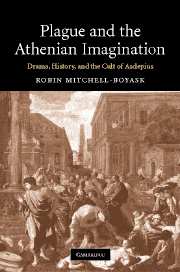Book contents
- Frontmatter
- Contents
- Preface
- Prologue
- Figure 1
- Chapter 1 Introduction
- Chapter 2 Death, myth and drama before the plague
- Chapter 3 Materials I: The language of disease in tragedy
- Chapter 4 Plague, cult and drama: Euripides' Hippolytus
- Chapter 5 Oedipus and the plague
- Chapter 6 The Trachiniae and the plague
- Chapter 7 Materials II: The cult of Asclepius and the Theater of Dionysus
- Chapter 8 Disease and stasis in Euripidean drama: Tragic pharmacology on the south slope of the Acropolis
- Chapter 9 The Athenian Asklepieion and the end of the Philoctetes
- Chapter 10 Conclusions and afterthoughts
- Works Cited
- Index
Chapter 8 - Disease and stasis in Euripidean drama: Tragic pharmacology on the south slope of the Acropolis
Published online by Cambridge University Press: 22 September 2009
- Frontmatter
- Contents
- Preface
- Prologue
- Figure 1
- Chapter 1 Introduction
- Chapter 2 Death, myth and drama before the plague
- Chapter 3 Materials I: The language of disease in tragedy
- Chapter 4 Plague, cult and drama: Euripides' Hippolytus
- Chapter 5 Oedipus and the plague
- Chapter 6 The Trachiniae and the plague
- Chapter 7 Materials II: The cult of Asclepius and the Theater of Dionysus
- Chapter 8 Disease and stasis in Euripidean drama: Tragic pharmacology on the south slope of the Acropolis
- Chapter 9 The Athenian Asklepieion and the end of the Philoctetes
- Chapter 10 Conclusions and afterthoughts
- Works Cited
- Index
Summary
I earlier suggested how Euripides' Hippolytus, read as a plague drama rife with disease metaphors, rituals designed to ward off plague and famine, and allusions to Asclepius, emerges as a more topically significant and historically richer drama. The Oedipus Tyrannus of Sophocles and the Trachiniae were likely composed during or soon after the last attacks of the plague, the influence of which we see throughout both. These dramas are in the first wave of the plague's effect, with the second wave coming roughly a decade later because of the new Asklepieion next to the theater and because political conditions in Athens lent themselves to a revivification of the metaphor of the sick city. After the construction of the Asklepieion gets underway around 420 bce, patterns of nosological imagery and civic stasis intensify in Euripidean drama, and they continue through the subsequent decade. In this chapter I shall focus primarily on two Euripidean tragedies that are broadly concerned with nosological discourse, the Heracles and the Phoenissae, though I shall also be bringing to my study, as needed, other tragedies which survive both complete and in fragments. My discussion will be somewhat circuitous, as I internally frame a broader examination of the Heracles with an analysis of aspects of the Phoenissae and other dramas composed during the same period (including ones that only survive in fragments), but this path will enable a clearer understanding of the nosological dynamics in the Heracles.
- Type
- Chapter
- Information
- Plague and the Athenian ImaginationDrama, History, and the Cult of Asclepius, pp. 122 - 152Publisher: Cambridge University PressPrint publication year: 2007



